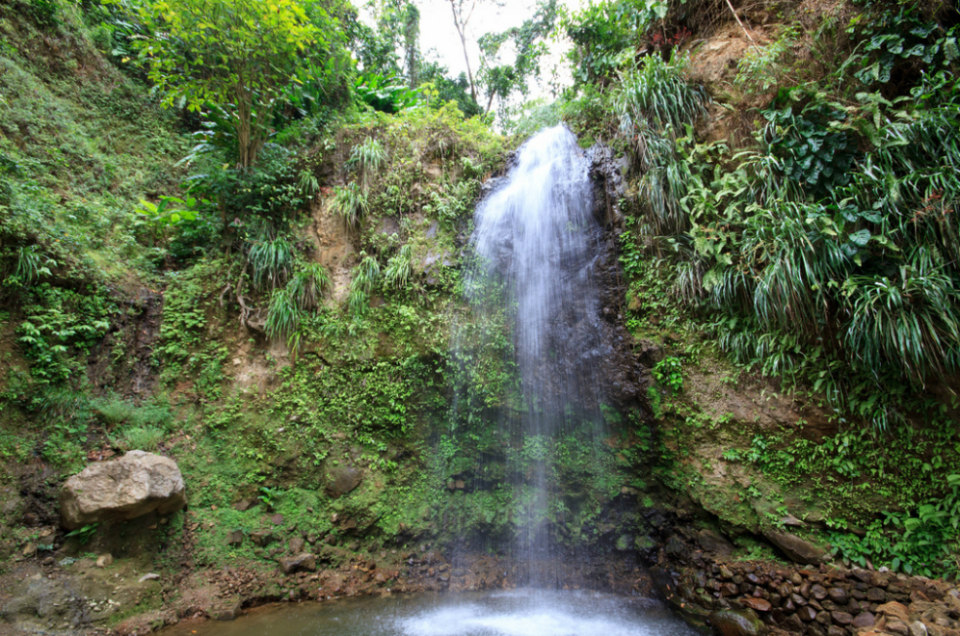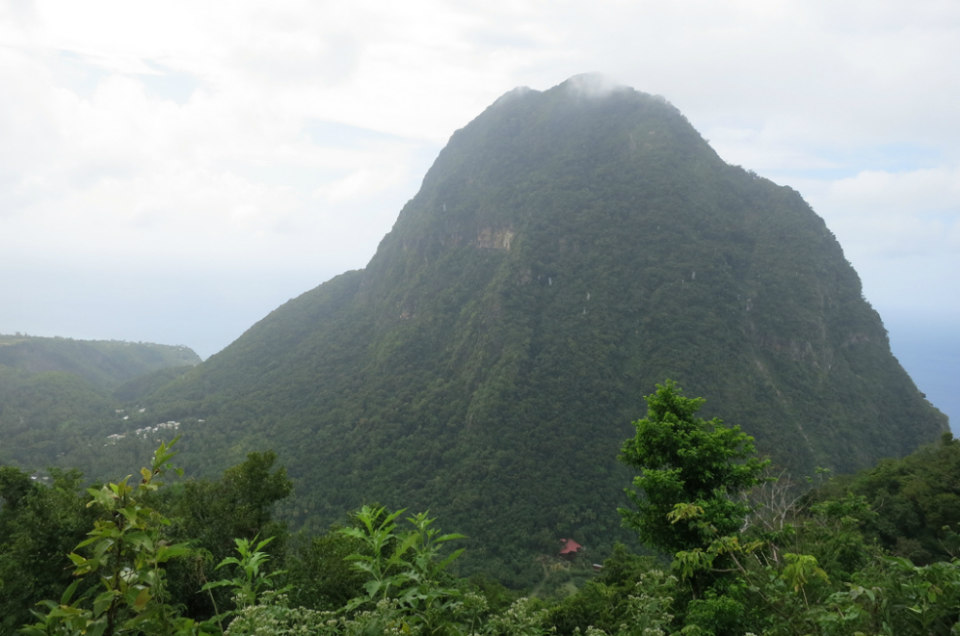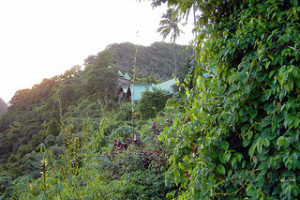A Caribbean vacation, like most other tropical island getaways, is commonly associated with hedonistic resorts, with pampering and relaxation. Me? I wanted none of those things. Exhausted by the languor of lying on a beach, I sought a getaway that could deliver more than just a suntan. So on my first trip to the Lesser Antilles island of St. Lucia (and my twelfth trip to the Caribbean) I traded in crystalline blue waters for shades of emerald, moss and jade found on terra firma. Instead of snorkeling or other water activities, I hiked up the 2,618-foot Gros Piton, the larger of the two vertigo-inducing peaks that plunge spectacularly into the sea on the southwest coast of the island. After all, who needs the sea when there are mineral springs, a lush rainforest, picture perfect waterfalls and a walk-in volcano.
In my quest to avoid the beach altogether, I checked into a hilltop resort nestled among the mango groves, the giant ferns and papaya trees. Ladera is all about being as close to the island’s lush natural environment—without having to actually pitch a tent. Perched upon a volcanic ridge a thousand feet above sea level, the one-of-a-kind eco-lodge rooms are built from stone and polished tropical wood. Mahogany four-poster beds draped in mosquito nets, wooden beamed ceilings, sisal rugs and landscaped decks outfitted with grotto-style plunge pools complete the luxury tree-house vibe. It’s not what Ladera rooms have but rather what they do not that makes it a favorite with honeymooners and nature-lovers. Thanks to the lack of a fourth wall, guest rooms feature uninterrupted views of the triangular-shaped twin Piton mountains and the cobalt blue sea. Instead of air conditioning, a continuous cool breeze keeps things comfortable at night.
I found that with no TV or stereo in the room, my nighttime ritual became watching the stars and falling asleep—albeit with some difficulty—to the thunderous twittering and chirping of birds, insects, crickets and tree frogs.
Starting out early in the morning so as to avoid the heat, I met up with my guide, Rose, at the foot of the mountain in the community of Fond Gens Libre a short distance from the town of Soufriere. The “Valley of the Free People” settlement dates back to the 1700s and was used as a secure haven for black freedom fighters during the slave rebellion of 1748. In fact, some of the descendents still live there and serve as hiking guides. Winding our way through dense vegetation, Rose pointed out various caves that were used as shelters for the Brigands and the Amerindians before them.
The trail started out relatively easy but quickly became steeper and more challenging as we hiked over tricky footholds, loose rocks and slippery roots. Suddenly, a toothpick-thin Rastafarian dashed past us, carrying a sack that surely weighed more than him. “What’s in the bag?” I asked Rose once he was out of sight. “Water,” Rose said. And I thought I got thirsty when I exercised. “For his plants,” she said raising an eyebrow. I was about to ask why he grew plants in such a difficult-to-get-to location and then I understood. “The young plants don’t survive without water. So they have to hike up here sometimes two or three times a week if it doesn’t rain.” The police, Rose added, are supposed to do frequent searches in the mountains to locate and destroy the Rastas’ marijuana crops. “But it’s quite a hike so they don’t come up here that often. And they never find anything.”
St. Lucia’s most stunning beauty can be found the higher you go in the mountains and rainforest where the tropical vegetation becomes more verdant and provides more shelter for the birds and mongoose. The medicinal practices of the Carib Indians are commonplace in St. Lucia, where stories, legends and myths are associated with just about every tree, plant and bird. Rose pointed out the cactus that Rastafarians use for moisturizing their hair and the almacigo tree, which locals call “peeling tourist tree” owing to its red, peeling bark. “The tree looks like the sunburned skin of those English folks we just saw hiking down,” Rose said. She also told me about Papa Bois, the ghostly Father of the Forest who, as a punishment for assaults on his realm, leads hunters and woodcutters astray.
“We’re almost there,” Rose said for the twelfth time. But I no longer believed her. “Are you sure you know where you’re going?” I asked, hoping—no, praying—that she’d fess up and we’d turn around and go home.
“You can’t quit now,” she said laughing. And so we climbed on and finally reached the summit where a hip lounge with comfy recliner chairs awaited and the locally grown house “special” was being passed around. Just kidding. As I hoped, the view was indeed worth the effort. Rose pointed to the town of Vieux Fort and many settlements tucked away between the coconut palms and papaya trees. Across the Atlantic Ocean we could even make out the island of St. Vincent. A bit farther north, a spur trail led to a viewpoint, which we reached by climbing some rickety wooden ladders through a mini jungle, of Petit Piton.
Sitting down for a rest and to admire the view, I devoured the small sandwich and fruit the hotel had packed for me and listened in on an animated discussion that three other hikers were having about the island’s best waterfall. Once I eventually got my breath under control, Rose and I began the even more challenging descent. At around the half-way point we crossed paths with another group of trekkers and their guide, a sprightly woman of 50 going on 20 who hiked barefoot. (I swear.) “How much longer?” whined a teenage boy, already drenched in sweat. Before his guide had a chance to reply, I called back, “You’re almost there.”
With Gros Pitons out of the way, I spent the rest of my time on St. Lucia searching for my perfect waterfall. The best part: no irksome grains of sand to deal with when I got home.





